|
| |||
| (Back to Preceding Week; on to Next Week) |
|
All text & photos © Hilton Pond Center SEE LIKE A HUMMINGBIRD Whenever we capture and band hummingbirds during public programs, we sometimes hear comments from folks who assume the birds are under great stress. Personally, we doubt hummers are stressed by the experience, and we're certain there's no long-term damage to these tiny birds. After all, when we carefully grasp them and insert their bills in a sugar water feeder, they almost always drink. Furthermore, it's not uncommon to catch a Ruby-throated Hummingbird, band it, and release it at Hilton Pond Center--only to recapture it in the very same trap within the hour, sometimes much sooner. We seriously doubt a bird that feeds while in-the-hand and that re-enters the same trap--sometimes hundreds of times during a season and even in successive years--suffers any damage, psychological or otherwise. That said, we're always considering the hummingbird's welfare when we band, but there's no way we can know what a hummingbird really thinks about the banding experience--assuming it can think at all about such things. We also can't fly or build nests or feed or migrate like a hummer, but this week we thought we might try at least to SEE like one.
All text & photos © Hilton Pond Center Here at Hilton Pond Center we maintain quite a few hummer feeders, but from June through September we observe many Ruby-throated Hummingbirds sampling natural nectar at the plant we call the "hummingbird magnet." We're referring to Trumpet Creeper, Campsis radicans, a native flowering vine that occurs in nearly every state where ruby-throats breed. When asked what to plant to attract hummers, we always advise starting with Trumpet Creeper. It may grow a little vigorously for some gardeners, but those who train it to climb a tree or trellis or fence will be rewarded by brilliant orange-red four-inch blooms (above) that are a hummingbird favorite. Outside the kitchen window of our old farmhouse at the Center is a massive thicket of Trumpet Creeper that annually produces thousands of blossoms--each of which likely is visited at least once by one of our local hummers.
All text & photos © Hilton Pond Center Most flowers on Trumpet Creeper vines hang horizontally or pointing slightly downward, so a hummingbird typically hovers just in front of the blossom and repeatedly inserts its bill and head (above). Occasionally we see a ruby-throat using its feet to grasp the lower petals of the flower tube while feeding; such birds always appear to be recently fledged youngsters who haven't yet developed good wing-eye coordination.
All text & photos © Hilton Pond Center It's obvious the hummingbird's bill is just the right length to reach nectar deposits at the far end of the Trumpet Creeper's tubular flower. And it's pretty apparent the bright orange of the Trumpet Creeper's flower--especially in contrast with the vine's deep green foliage--attracts the attention of hummingbird pollinators, so we think it's safe to conclude hummingbirds can see color. But just what DOES a hummer see as it approaches the Trumpet Creeper blossom? Why, the same thing we humans do if we look really closely: The reproductive structures of the flower (above). Humans and hummingbirds alike can see the delta-shaped end of a pistil and four stamens tipped with wavy pollen-bearing anthers. If you're a hummingbird, however, you get a whole different perspective when your head passes through the mouth of the Trumpet Creeper flower on the way to the nectar reward at the other end. Assuming a ruby-throat doesn't close its eyes while it feeds, the photo above reveals what the hummingbird probably sees when it begins to probe the blossom of a Trumpet Creeper. (Click on the image to enlarge it and then lean close to your screen for an even more realistic, life-sized effect.) As the hummer inserts its bill into the blossom, dead ahead of its forehead is the long flower tube--along whose top margin are those four stamens and single pistil.
All text & photos © Hilton Pond Center The pistil is a long, thin structure that begins at the ovary at the base of the flower tube, extends between the stamens, and ends in a stigma that splits into two flaps (above). The stigma is only about an eighth of an inch across, so in the photomicrographic view above we humans can probably see more detail than the hummingbird. The inner surface of each flap of the stigma is covered by a velvety layer of tiny plant hairs to which yellow Trumpet Creeper pollen grains adhere.
All text & photos © Hilton Pond Center To reveal the structure of the stamens, we slit open a Trumpet Creeper flower tube, removed the pistil, and rolled back the margins of the petals (above). Unlike the pistil, which emanates freely from the ovary at the base of the blossom, the filaments of the stamens are embedded in petal walls until just before the mouth of the flower. (By the way, did you notice the brown mini-beetle in the photo?)
All text & photos © Hilton Pond Center It's quite significant the stamens and pistil all terminate along the TOP margin of the corolla; this configuration allows each structure to make contact with the hummer's forehead as the bird enters a Trumpet Creeper flower to feed. When the hummer visits its first flower of the day, its head merely slides past the pistil and then contacts the stamens, picking up pollen from the stamens (see photomicrographic view above of anther lobe with pollen). At the next flower, the hummingbird again inserts its bill and head into the Trumpet Creeper, but this time hitchhiking pollen from the hummer's forehead and crown contact the stigma of the pistil and a few grains are left behind. If the pollen is viable, at least one grain will begin dividing and form a pollen tube that grows down the length of the pistil to the ovary, where fertilization occurs.
All text & photos © Hilton Pond Center Based on our observations of Trumpet Creeper blossoms at Hilton Pond Center, it appears the flaps of the stigma might fold together after fertilization occurs. What we DO know is that shortly after fertilization, the flower tube falls off (above), leaving the pistil attached to the ovary--which itself is surrounded and protected by a dark orange cup-like structure formed by fused sepals.
All text & photos © Hilton Pond Center Within a few days after fertilization, the pistil withers and turns brown and the ovary already will have grown to noticeable size (above). By late summer or early fall it will become an elongated five-inch green pod containing dozens of dry, flattened seeds--future progeny of the Trumpet Creeper.
That said, not every ruby-throat that samples a Trumpet Creeper's nectar load returns the favor by cross-pollinating. Young hummers in particular--those that haven't quite figured out how to forage efficiently--often visit a Trumpet Creeper flower and miss its mouth completely, probing instead in the gap between the base of the flower tube and the sepals. Oddly enough, this sometimes works if the tube is loose, so the fledgling hummingbird gets at least a little lunch after all. We've also seen Carpenter Bees bypassing their pollination duties in this way.
All text & photos © Hilton Pond Center Of greater significance is the plethora of insects--especially ants--that neither enter the Trumpet Creeper flower nor patronize the gap at the base of the floral tube. These industrious insects seem much more interested in hanging out on the sepals and even on petioles, the stems that attach flowers and leaves to the vine. Even though the Trumpet Creeper devotes considerable energy to producing nectar within its flower tubes, it also offers sweet elixir in "extrafloral nectaries"--tiny glands (as on the sepals, above) that make just enough nectar to attract the attention of tiny insects.
All text & photos © Hilton Pond Center At higher magnification (above) we see the pimple-like extrafloral glands produce little droplets of fluid that apparently are chemically identical to nectar within the Trumpet Creeper flower. So why should a plant bother to make nectar to reward insects that DON'T pollinate? The answer lies in the nature of many ant species thatm attracted to the carbohydrate-laden extrafloral nectaries, also end up taking a little protein in the form of thrips, aphids, leaf hoppers, and other plant-sucking or chewing insects that might otherwise harm a Trumpet Creeper flower. Hilton Pond's Ruby-throated Hummingbirds go about their business lapping up nectar AND serving as pollinators, using their eyes (below) to see everything we've just described about Trumpet Creepers. Thanks to the photos above you, too, can see like a hummingbird--PLUS you get the added benefit of using your big cerebral hemispheres to ponder the wonder of it all.
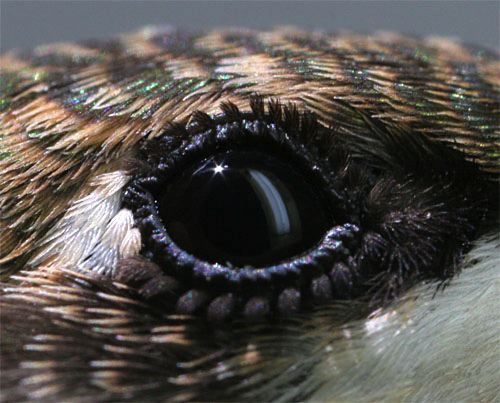 All text & photos © Hilton Pond Center All contributions are tax-deductible |
 The Piedmont Naturalist, Volume 1 (1986)--long out-of-print--has been re-published by author Bill Hilton Jr. as an e-Book downloadable to read on your iPad, iPhone, Nook, Kindle, or desktop computer. Click on the image at left for information about ordering. All proceeds benefit education, research, and conservation work of Hilton Pond Center for Piedmont Natural History. The Piedmont Naturalist, Volume 1 (1986)--long out-of-print--has been re-published by author Bill Hilton Jr. as an e-Book downloadable to read on your iPad, iPhone, Nook, Kindle, or desktop computer. Click on the image at left for information about ordering. All proceeds benefit education, research, and conservation work of Hilton Pond Center for Piedmont Natural History. |
|
"This Week at Hilton Pond" is written and photographed by Bill Hilton Jr., executive director of Hilton Pond Center for Piedmont Natural History |
|
Please refer "This Week at Hilton Pond" to others by clicking on this button: |
Comments or questions about this week's installment? Send an E-mail to INFO. (Be sure to scroll down for a tally of birds banded/recaptured during the period, plus other nature notes.) |

Click on image at right for live Web cam of Hilton Pond,
plus daily weather summary
Transmission of weather data from Hilton Pond Center via WeatherSnoopfor Mac.
--SEARCH OUR SITE-- For a free on-line subscription to "This Week at Hilton Pond," send us an |



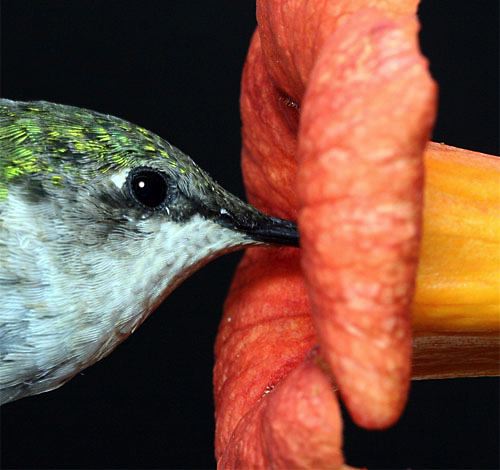
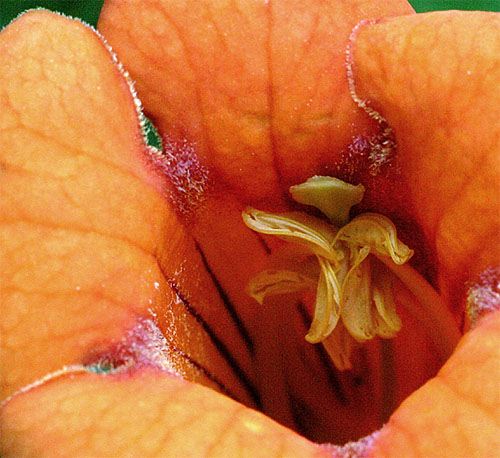
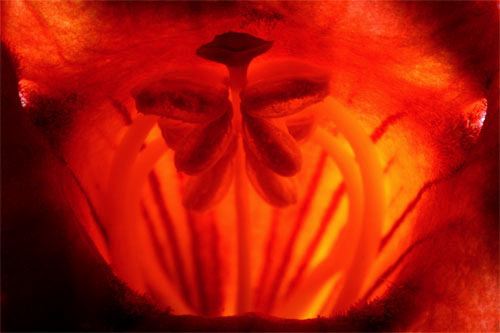
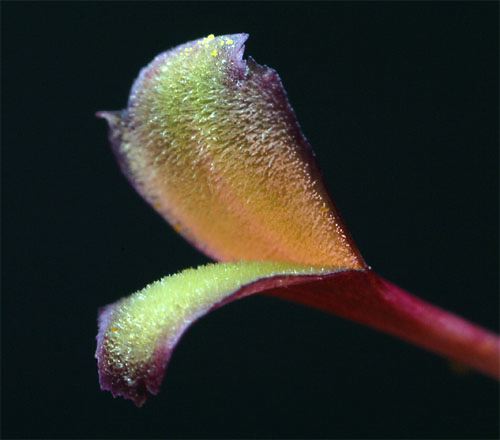
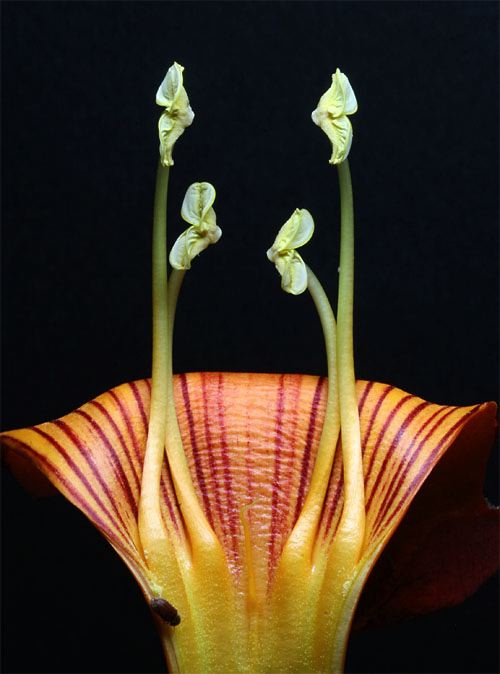

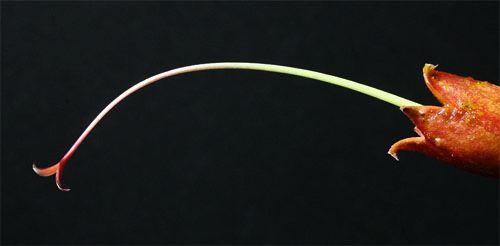
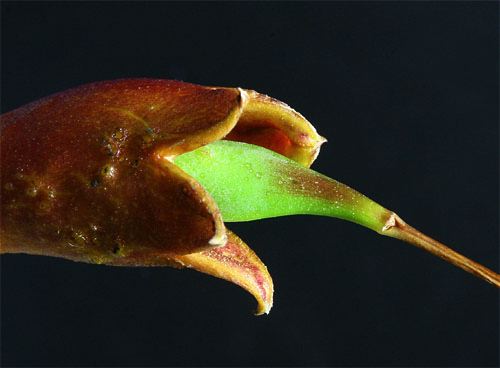
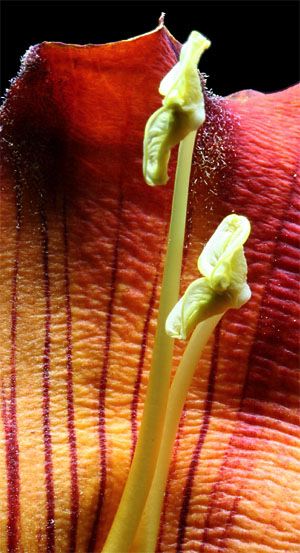 It's interesting the interior surface of a Trumpet Creeper flower is marked with dark red parallel lines (right), so-called "bee guides" that may function to draw insects into the flower. The vast majority of nectar-seeking invertebrates that visit Trumpet Creeper blossoms--ants, native bees and flies, beetles, etc.--probably don't end up becoming pollinators simply because they're so small they crawl right past the stamens and pistil without ever touching them. Larger insects such as Carpenter Bees and some Bumblebee species are big enough to bump into the flower's reproductive parts; their fuzzy bodies apparently do pick up pollen and transport it among Trumpet Creeper flowers. We believe it's safe to say, however, that Ruby-throated Hummingbirds are by far the most important pollinators of Trumpet Creeper.
It's interesting the interior surface of a Trumpet Creeper flower is marked with dark red parallel lines (right), so-called "bee guides" that may function to draw insects into the flower. The vast majority of nectar-seeking invertebrates that visit Trumpet Creeper blossoms--ants, native bees and flies, beetles, etc.--probably don't end up becoming pollinators simply because they're so small they crawl right past the stamens and pistil without ever touching them. Larger insects such as Carpenter Bees and some Bumblebee species are big enough to bump into the flower's reproductive parts; their fuzzy bodies apparently do pick up pollen and transport it among Trumpet Creeper flowers. We believe it's safe to say, however, that Ruby-throated Hummingbirds are by far the most important pollinators of Trumpet Creeper.
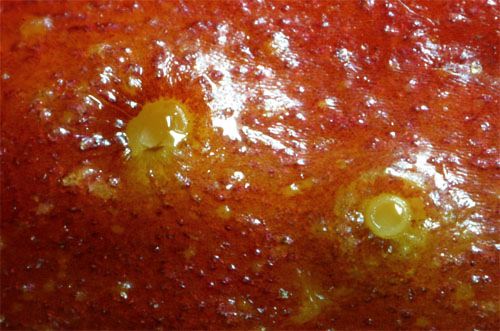
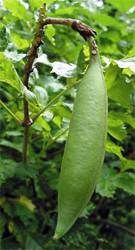 Particularly aggressive ants might deter larger animals such as lizards and birds that could damage a flower while seeking out nectar. Amazingly, there are even EFNs--extrafloral nectaries--on those green seed pods (right) that grow from a Trumpet Creeper ovary, the better to attract ants that in turn prey upon insects that might bore into the pod, eating and destroying seeds. So, even though some creatures that visit EFNs don't play the pollination role, they still provide a valuable protective service for Trumpet Creeper flowers and seeds.
Particularly aggressive ants might deter larger animals such as lizards and birds that could damage a flower while seeking out nectar. Amazingly, there are even EFNs--extrafloral nectaries--on those green seed pods (right) that grow from a Trumpet Creeper ovary, the better to attract ants that in turn prey upon insects that might bore into the pod, eating and destroying seeds. So, even though some creatures that visit EFNs don't play the pollination role, they still provide a valuable protective service for Trumpet Creeper flowers and seeds. 

 Please report your
Please report your
